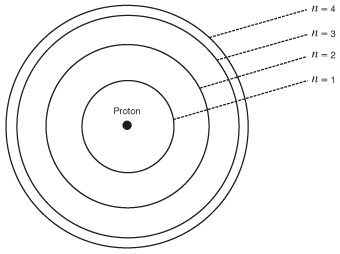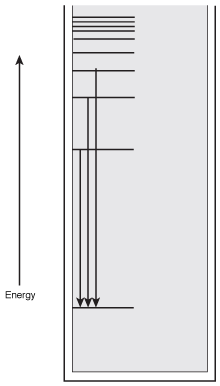Chemistry: Bohr: What Is It Good For?
Bohr: What Is It Good For?
While many theorists were busy playing with cathode ray tubes or shooting alpha particles at gold foil, Niels Bohr was busy thinking about hydrogen. As it turns out, when energy is added to a sample of hydrogen it creates a very unusual emission spectrum, as shown in the following figure.

Figure 5.1When energy is added to hydrogen, light is given off only at particular energies. Bohr used the energies of these bands of light to devise his planetary model of the atom.
Let's go back a second. You've probably seen at some point in your life how a prism can be used to break white light up into a rainbow of colors. This rainbow is referred to as a continuous spectrum, because it breaks light into a continuous band of colors. This differs in appearance from a line spectrum, which shows only certain colors of light that correspond to certain energies.
The Mole Says
The energy of light is closely related to its color. High energy light appears purple, low energy light appears red, and intermediate energies of light have intermediate colors such as blue, green, yellow, and orange.
Bohr was puzzled by the lines given off by hydrogen. What could be causing them? Why didn't hydrogen give off a continuous spectrum? After initially playing with and discarding the idea that demons were responsible, he developed what's now frequently referred to as the planetary model of the atom.
In his planetary model, Bohr suggested that electrons travel around the nucleus in circular orbits, just as the planets revolve around the sun. Because the nucleus is positively charged and the electrons have a negative charge, the pull of the nucleus serves to keep the electrons near it, much as the pull of gravity keeps the planets near the sun. The paths that the electrons traveled were referred to as orbitals.

Figure 5.2Bohr believed that electrons rotated around the nucleus in exactly the same way that the planets revolve around the sun.
That wasn't all. In addition, Bohr believed that the farther away from the nucleus the electrons were, the more energy they had. According to his model, the electrons couldn't have just any random energy—their energies were determined by the order in which the orbitals were located from the nucleus. This order was denoted by the variable n, with the nearest orbital to the nucleus being equal to n=1, the second nearest being equal to n=2, and so on.
In Bohr's model, when energy is added to an atom it causes electrons to move from an orbital close to the nucleus to orbitals that are farther away. The starting orbital is called the ground state and the orbital it ends up in is called the excited state. However, much like a child who's eaten 15 pounds of chocolate on Halloween, eventually the electrons come down from their excited state and reenter the ground state.
Molecular Meanings
The ground state is the low-energy state where you can initially find electrons. When energy is added to the atom, the electrons may use this energy to jump into a higher-energy state called the excited state.
Now the energy that excited the electrons has to go somewhere. After all, it can't just vanish into thin air. When the electron falls back down to the ground state, the energy is given off as light. The energy of the light is equal to the difference in energy between the ground state and the excited state. Because there are several different excited states that electrons can jump into, there are several different energies of light emitted during this process. Bohr was a very happy guy when he saw that the energies of light predicted by his equation matched the energies of light given off in the hydrogen spectrum. He was even happier when this discovery won him the 1922 Nobel Prize for Physics.

Figure 5.3The energy of the light that is emitted from an atom is equal to the difference in energy between the excited state and the ground state. As Bohr predicted, the colors of light indicated by his theory matched those in the line spectrum of hydrogen.
Excerpted from The Complete Idiot's Guide to Chemistry © 2003 by Ian Guch. All rights reserved including the right of reproduction in whole or in part in any form. Used by arrangement with Alpha Books, a member of Penguin Group (USA) Inc.
To order this book direct from the publisher, visit the Penguin USA website or call 1-800-253-6476. You can also purchase this book at Amazon.com and Barnes & Noble.







